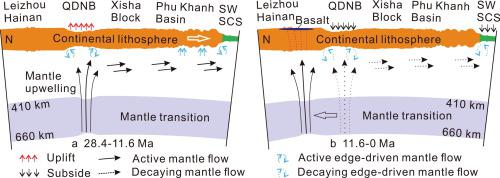Geoscience Frontiers ( IF 8.5 ) Pub Date : 2021-06-17 , DOI: 10.1016/j.gsf.2021.101246 Zhong-Xian Zhao

|
Deep hot mantle upwelling is widely revealed around the Qiongdongnan Basin on the northwestern South China Sea margin. However, when and how it influenced the hyper-extended basin is unclear. To resolve these issues, a detailed analysis of the Cenozoic time-varying residual subsidence derived by subtracting the predicted subsidence from the backstripped subsidence was performed along a new seismic reflection line in the western Qiongdongnan Basin. For the first time, a method is proposed to calculate the time-varying strain rates constrained by the faults growth rates, on basis of which, the predicted basement subsidence is obtained with a basin- and lithosphere-scale coupled finite extension model, and the backstripped subsidence is accurately recovered with a modified technique of backstripping to eliminate the effects of later episodes of rifting on earlier sediment thickness. Results show no residual subsidence in 45–28.4 Ma. But after 28.4 Ma, negative residual subsidence occurred, reached and remained ca. −1000 m during 23–11.6 Ma, and reduced dramatically after 11.6 Ma. In the syn-rift period (45–23 Ma), the residual subsidence is ca. −1000 m, however in the post-rift period (23–0 Ma), it is positive of ca. 300 to 1300 m increasing southeastwards. These results suggest that the syn-rift subsidence deficit commenced at 28.4 Ma, while the post-rift excess subsidence occurred after 11.6 Ma. Combined with previous studies, it is inferred that the opposite residual subsidence in the syn- and post-rift periods with similar large wavelengths (>102 km) and km-scale amplitudes are the results of transient dynamic topography induced by deep mantle upwelling beneath the central QDNB, which started to influence the basin at ca. 28.4 Ma, continued into the Middle Miocene, and decayed at ca. 11.6 Ma. The initial mantle upwelling with significant dynamic uplift had precipitated considerable continental extension and faulting in the Late Oligocene (28.4–23 Ma). After ca. 11.6 Ma, strong mantle upwelling probably occurred beneath the Leizhou–Hainan area to form vast basaltic lava flow.
中文翻译:

南海西北部深部地幔上涌——从琼东南盆地时变残余沉降看
南海西北部边缘琼东南盆地周围广泛显露深部热地幔上涌。然而,它何时以及如何影响超延伸盆地尚不清楚。为了解决这些问题,沿着琼东南盆地西部的一条新地震反射线,对通过从后剥下沉中减去预测下沉得到的新生代时变残余下沉进行了详细分析。首次提出了一种计算受断层生长速率约束的时变应变速率的方法,在此基础上,结合盆地-岩石圈尺度耦合有限伸展模型,得到了预测的基底沉降,并且通过改进的后剥离技术准确恢复了后剥离的沉降,以消除后期裂谷对早期沉积物厚度的影响。结果显示在 45-28.4 Ma 内没有残余沉降。但是在 28.4 Ma 之后,出现了负残余沉降,达到并保持了大约。-1000 m 在 23-11.6 Ma 期间,并在 11.6 Ma 之后急剧减少。在里面同裂谷期(45-23 Ma),残余沉降约为。-1000 m,但是在裂谷后时期(23-0 Ma),它是大约为正的。300 至 1300 m 向东南增加。这些结果表明,SYN -rift沉陷赤字为28.4马云开始,而在后裂谷过剩陷发生后11.6马发生。结合前人的研究,推断在具有相似大波长(>10 2km) 和 km 尺度振幅是由中央 QDNB 下方的深部地幔上涌引起的瞬态动态地形的结果,它在大约 10 小时开始影响盆地。28.4 Ma,持续到中中新世,并在大约 11.6 马。在渐新世晚期(28.4-23 Ma),具有显着动力隆升的初始地幔上涌促成了相当大的大陆伸展和断层作用。在大约之后。11.6 Ma,雷州-海南地区下方可能发生强烈的地幔上涌,形成巨大的玄武岩熔岩流。











































 京公网安备 11010802027423号
京公网安备 11010802027423号